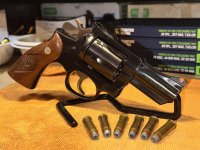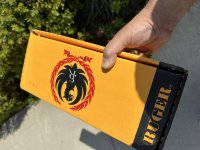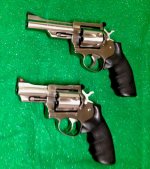I have never been a big fan of K frame Smiths. More on that anon. Despite that, and assuming S&W was the ideal choice for a PPC gun, I wanted a stainless K frame as the basis for my match gun.
The problem was there were none to be had. I came across the Ruger six series and asked my gunsmith if he could build a gun based on the Ruger and he said he could. That is how I got my first Ruger PPC revolver.
Prior to that my match revolver was a stock Smith model 19. I had zero issues with this revolver. This was used as a match revolver only. During this period it was not lost on me that at all PPC matches, S&W had a counter where two of their 'smiths would work on competitor's revolvers. They always had a line. Not overly confidence inspiring.
Back to the anon part. During part of this period my department switched from personally owned revolvers to mandatory carry 4"bbl model 66s. These experienced countless problems. When I went through the two week rangemaster course, by the time I finished I was on my third model 66.
But once I had a more experienced gunsmith further tune the action of my Ruger, it was just right. As long as I stayed away from loosening the adjustable main spring too much I had zero problems.
One time I and another shooting team member were out at the range practicing. He was an outstanding shot, always in the upper range of Calif Governor's 20 competitors. My wife and our German Shepherd (who was raised with guns and loved range trips) were also there.
As we were shooting, my buddy's revolver, built up on a Smith model 14, seized up. He took it apart and found that one of the frame mounted pins had broken. It was out of action until he could get it to a gunsmith. This was his only PPC revolver. He had no back up.
This was not lost on my bride. As we were driving home she told me I needed to have a back up revolver so as never to find myself in that situation. I went with another Ruger. I was comfortable and confident with my now perfected Ruger, and I wanted the identical feel.
When I got the new Ruger, I took it out and sighted it in, then set it aside just in case.
I had greatly underestimated Ruger toughness. 'Just in case' never came, all the way to when I retired from competition. That then-new PPC revolver still is.
But this is a Smith & Wesson forum, so on to that.
When Smith & Wesson brought out the L frames I was smitten. It just seemed to be the ideal size and weight to be tougher than the K frames and with muzzle heavy balance and stability.
Within the first year Bill Davis came to us with a great offer; he would trade 4" 686s straight across for our 4" 66s, and we only pay sales tax. I jumped on that for my patrol division. When we got rid of the 66s, we got rid of all the issues. The 686s served us extremely well until we transitioned to semi-autos (Glock).
I so like my 6" L frame, that I was able to get with the tall front sight for a neck hold for the 50 yard line, that I had it customized for competition use. Unfortunately various professional obligations spelled the end of enough time for matches, so it never did get tested in the heat of competition.
But it is, to me, the perfect PPC match revolver. And it had proven to be the ideal duty revolver.
For a 38/357 revolver I consider the L frames to be S&W's high water mark.
Even including my 27-2, I still consider the L frames to be perfection.









